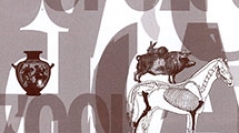

 Anthropozoologica
48 (2) - Pages 323-340
Anthropozoologica
48 (2) - Pages 323-340The “Cruz del Negro” necropolis in Carmona (Seville) is part of an archaeological site considered by some authors to be a Phoenician settlement. Findings from the paleobiological and taphonomic study conducted on the grave goods found in 38 funerary structures provide possible evidence to support this theory (along with other archaeological objects found there). Analysis of the animal remains found indicates three kinds of grave goods according to the animal species and anatomical parts offered, and points to a series of markers observed in other older sites located in the Mediterranean Basin which indicate the possible eastern origin of the funerary rituals practiced in “Cruz del Negro”. Of the 602 remains analysed, this study highlights the presence of 307 caprine (Caprinae) knucklebones in 15 of the 38 structures studied. Most of them are thermo-altered and highly polished, a practice originally found in Bronze Age sites in the Near East.
Necropolis, Knucklebones, Phoenicians, Iberian Peninsula, Paleobiology, Taphonomy.